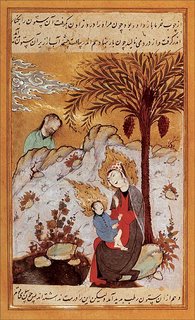Text: Books of the Word
To little Elias, born of two cultures
at a time when the world is quite strange ...

In this dark little room where the manuscripts shine like bright lights, the emotion is intense, but for those who aren’t lucky enough to be able to make it to Paris, the BnF has put a magnificent virtual exhibition online that presents the majority of the documents on display. I may be critical at times [fr], but in this case, I must admit that this is an excellent piece of work.
One of the documents that most struck me is this representation of the Virgin and Child taken from a Persian manuscript dating from the 16th century.

The prophets are marked out by the ring of golden flames around their heads (Islam hasn’t always rejected the representation of the prophets: the exhibition at the BnF even shows us some very beautiful representations of Mohammed). I imagine that most people know that Jesus (‘Issa), son of Mary (Maryam) is one of the prophets of Islam. I can’t help myself: my work means I have a compulsion to count everything. Who would suspect that Jesus is mentioned 28 times in the Koran? Mary is mentioned 34 times, more than in the Christian scriptures (19 times, in both the Gospel and the Acts put together). Abraham (Ibrahim) and Moses (Musa) are there too, 70 and 162 times respectively. Aaron (Harun), David (Dawud), Elijah (Ilyas), Elisha (Yash’a), Isaac (‘Ishaq), Jacob (Yaqub), Job (Ayyub), Jonah (Yunus), Noah (Nuh), Solomon (Sulaiman) and Zachary (Zakariyya) also put in an appearance, along with many others …
But let’s return to the BnF. I was moved by the fragments of the Epistles of Paul in Arabic from the 9th and 10th centuries, and by a Pentateuch in Arabic from the 16th century, used by Jews in Egypt. These are beautiful symbols that show the secular mix of cultures around the Mediterranean.
I’m not going to take you through the whole exhibition: go and see for yourself, it’s worth a visit. I’ll just end by mentioning that the room (surprisingly lacking in security measures) contains what I believe to be the first caricature of the Prophet Mohammed.

This manuscript (which is truly tiny: I’d seen it in a photograph, but was surprised when I saw its real size) is the first translation into Latin of the Koran, carried out around 1140 on the orders of Peter the Venerable, abbot of Cluny. This is no ecumenical work; it was translated with the aim of understanding Islam in order to fight it. Mohammed is mentioned as the “pseudo-prophet” and represented on this page with a fish tail and feathers on his body. Hardly a fine example of tolerance. And I believe matters were even taken a bit further not long afterwards; the second crusade began in 1147. So we too know all about fanaticism (and indeed we still do): yet another point we have in common.











1 Commentaires:
Great! Thank you very much for translating this one.
Enregistrer un commentaire